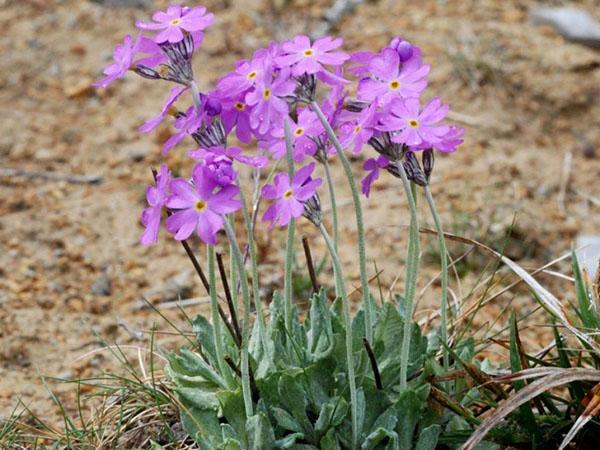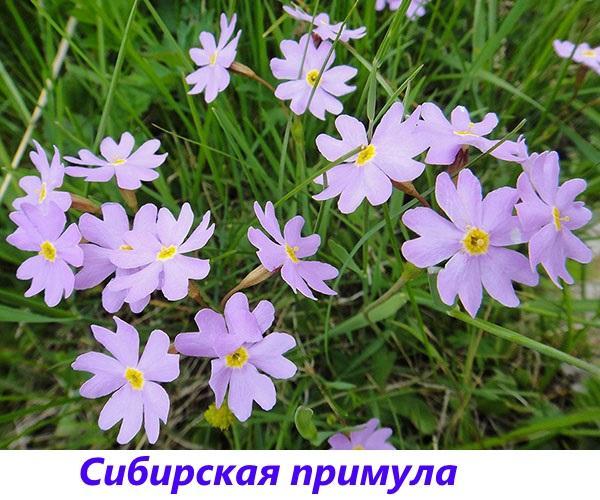The main types and varieties of primrose: description, features
 The species and varieties of primrose amaze with their variety and shades of buds. These are unique flowers that bloom in early spring, bring with them the approach of warmth and sunny days, delight with their bright colors. At present, researchers are actively working on the development of more and more new varieties, of which more than 500 are currently known. Primula can be grown not only in a personal plot, but also in an apartment, where it can form flowers for a whole year. Which cannot but please housewives.
The species and varieties of primrose amaze with their variety and shades of buds. These are unique flowers that bloom in early spring, bring with them the approach of warmth and sunny days, delight with their bright colors. At present, researchers are actively working on the development of more and more new varieties, of which more than 500 are currently known. Primula can be grown not only in a personal plot, but also in an apartment, where it can form flowers for a whole year. Which cannot but please housewives.
Types and varieties of powdery primroses

For a flowerbed with primroses to bloom every year, you need to periodically plant flowers.
The most common types are:
- Siberian primrose. This type of plant grows in steppe meadows and forests. Reaches 27 cm in height, primrose leaves are rapidly tapering to the bottom. The flowers are colored deep pink. Several buds form an umbrella-shaped inflorescence. Flowering occurs in early summer and lasts about three weeks. The plant propagates by seeds. With proper care, the Siberian species lives for several years.

- Scottish primrose. It is also a powdery primrose that can be found on alpine coaster... The plant develops well at low air humidity. It is better to feed the flower with mineral fertilizers, periodically adding them to the soil.

Section OREOPHLOMIS
 This group includes perennial primroses. Flowers of such plants grow small or medium. You can see them, as a rule, in early spring. The buds are pink with a yellow tint. Smooth serrated leaves.
This group includes perennial primroses. Flowers of such plants grow small or medium. You can see them, as a rule, in early spring. The buds are pink with a yellow tint. Smooth serrated leaves.
The pink primrose also belongs to this section. Peduncles in this species reach a length of 13-15 cm. The buds appear in May, and the leaves begin to set only after all the flowers have bloomed. Most often it can be found on swampy soils, reproduction is carried out by seeds or by dividing the bush.
Auricula section
 This section includes more than 20 species. The main habitat is the lands of Europe. As a rule, these are low bushes, throwing out purple, lilac flowers with a yellow or white core.
This section includes more than 20 species. The main habitat is the lands of Europe. As a rule, these are low bushes, throwing out purple, lilac flowers with a yellow or white core.
The following varieties are often found:
- Pubescent primrose. It is a cultivar derived from auricular primrose and can have any flower shade. It also includes English primroses (white middle, stripes coming out of the center, there is a powdery bloom), Belgian primroses (two-color and one-color buds without bloom), as well as terry.

- Primula ear. This plant is resistant to cold weather, thrives in the shade and in the sun, develops rapidly in fertile moist soil. It is very important for the plant to get enough calcium. In the natural environment, it is found in England. The leaves of the plant have teeth, the flowers are often yellow, but other shades are also found.

Cortex Primroses Section
 This section contains more than 20 species. The flowers of the plant are funnel-shaped, they do not have a powdery bloom, the leaves have petioles. If the soil is fertile, then the primrose will grow equally well both in sunlight and in shady areas.
This section contains more than 20 species. The flowers of the plant are funnel-shaped, they do not have a powdery bloom, the leaves have petioles. If the soil is fertile, then the primrose will grow equally well both in sunlight and in shady areas.
Primula cortex
 This species is most common throughout Eurasia. A distinctive feature is the horizontal short rhizome. The leaves have denticles, grow on thin petioles. The flowers grow from umbrella-shaped inflorescences. Each has several purple-red buds. The flowers are characterized by a deep groove in the middle. Their diameter is 1.5 cm.The buds bloom usually in late spring or early summer.
This species is most common throughout Eurasia. A distinctive feature is the horizontal short rhizome. The leaves have denticles, grow on thin petioles. The flowers grow from umbrella-shaped inflorescences. Each has several purple-red buds. The flowers are characterized by a deep groove in the middle. Their diameter is 1.5 cm.The buds bloom usually in late spring or early summer.
Siebold primrose
 These flowers grow down, up, or sideways. They have a special color and bud shape. When loose, they can be pink, lavender, dark red, white, or purple.
These flowers grow down, up, or sideways. They have a special color and bud shape. When loose, they can be pink, lavender, dark red, white, or purple.
Some Siebold primrose flowers are two-colored: the shade is different inside and outside.
Primrose rejected
 The height of this perennial flower reaches 35-40 cm. The primrose grows well in a short period of time due to a well-developed root system. The leaves reach 8-10 cm in length, have the shape of an ellipse, the base is equipped with a weak core. Flowers are located on thin and low-drooped stems.
The height of this perennial flower reaches 35-40 cm. The primrose grows well in a short period of time due to a well-developed root system. The leaves reach 8-10 cm in length, have the shape of an ellipse, the base is equipped with a weak core. Flowers are located on thin and low-drooped stems.
Section of dentate primroses
 This includes those types of primroses in which the flowers form a large inflorescence. The most popular representative is the toothed primrose. In nature, it can be seen in China. The plant also has a white bloom. The leaves are light in color. Flowers appear on long peduncles reaching 22-24 cm. Lilac, white, purple buds bloom in April. Flowering lasts a little over a month. They perfectly tolerate cold, propagate by seeds. Grow equally well under the sun and in the shade.
This includes those types of primroses in which the flowers form a large inflorescence. The most popular representative is the toothed primrose. In nature, it can be seen in China. The plant also has a white bloom. The leaves are light in color. Flowers appear on long peduncles reaching 22-24 cm. Lilac, white, purple buds bloom in April. Flowering lasts a little over a month. They perfectly tolerate cold, propagate by seeds. Grow equally well under the sun and in the shade.
Muscarioides section
 This includes almost 20 species of primroses, whose inflorescences are shaped like sharp cylinders. These varieties are common in Asia. In winter, the plant needs to be covered, and during the growing season, it should be watered often and a lot.
This includes almost 20 species of primroses, whose inflorescences are shaped like sharp cylinders. These varieties are common in Asia. In winter, the plant needs to be covered, and during the growing season, it should be watered often and a lot.
Primrose viala
 This plant is perennial, rather tall (reaches half a meter in height). Inflorescences resemble spikelets, flowers are distinguished by a pink-lilac shade. Leaves are bright green, slightly wrinkled. Viala primrose blooms in mid-summer. This process continues for a little over a month. Feels best in loose, moist, fertile soil in the sun or partial shade. For the winter, the plant needs to be well covered.
This plant is perennial, rather tall (reaches half a meter in height). Inflorescences resemble spikelets, flowers are distinguished by a pink-lilac shade. Leaves are bright green, slightly wrinkled. Viala primrose blooms in mid-summer. This process continues for a little over a month. Feels best in loose, moist, fertile soil in the sun or partial shade. For the winter, the plant needs to be well covered.
Candelabra primroses section
 This group includes about 30 species. Such plants are distinguished by long peduncles that appear in the summer months. In order for the bushes to quickly sprout in the spring and delight them with their flowering as early as possible, they need to be covered with special agrofibre for the winter. How primroses look from the candelabra section can be seen in the photo.
This group includes about 30 species. Such plants are distinguished by long peduncles that appear in the summer months. In order for the bushes to quickly sprout in the spring and delight them with their flowering as early as possible, they need to be covered with special agrofibre for the winter. How primroses look from the candelabra section can be seen in the photo.
In the sun, the primus flowers can lose their shade.
The most popular varieties of this group:
- Japanese primrose. The homeland of this flower is the territory of Japan. It can also be found on the Kuril Islands. Compared to other varieties, the Japanese primrose has a peduncle about 50 cm high. The buds are arranged in tiers. When loose, they can acquire a raspberry or snow-white hue. Such a primrose develops well on fertile soils in partial shade.

- Powdered primrose. This type is the most decorative among the candelabra section. In nature, the flower grows in the swampy areas of China. This species differs from others in a white bloom that covers the entire peduncle. Also, a small amount can be observed on the leaves.

Also included in this section is the primrose bull. This is a biennial, which, with proper care, can be a perennial. The flowers of this primrose are orange with a yellowish tint. All of them are collected in large inflorescences on a peduncle of about 50 cm. You can see the flowering from June to July.
Other types of primroses
 The most popular among primroses is the Florinda primrose. This is one of the largest flowers. Peduncles reach over a meter in height. At their top there are falling umbrellas.They are created from a variety of buds that are bell-shaped. They often take on a yellowish orange hue. In nature, such a primrose grows near water bodies. This is due to the fact that the flower is very fond of moisture. Therefore, in order to grow a primrose at home, you need to observe abundant watering and high humidity.
The most popular among primroses is the Florinda primrose. This is one of the largest flowers. Peduncles reach over a meter in height. At their top there are falling umbrellas.They are created from a variety of buds that are bell-shaped. They often take on a yellowish orange hue. In nature, such a primrose grows near water bodies. This is due to the fact that the flower is very fond of moisture. Therefore, in order to grow a primrose at home, you need to observe abundant watering and high humidity.
Primrose rubra
 Rubra primrose is no less popular. It is often called fine-toothed. The plant is distinguished by an unusual shape of inflorescences. In this primrose they are spherical. The buds are small. When opened, they can be burgundy, white, red. Inflorescences are located on a peduncle of a light green hue. Initially, it does not exceed 3 centimeters, but by the middle of flowering it already reaches 25 cm.
Rubra primrose is no less popular. It is often called fine-toothed. The plant is distinguished by an unusual shape of inflorescences. In this primrose they are spherical. The buds are small. When opened, they can be burgundy, white, red. Inflorescences are located on a peduncle of a light green hue. Initially, it does not exceed 3 centimeters, but by the middle of flowering it already reaches 25 cm.
Pallas primrose
 Pallas primrose is a medium flowering cultivar. The buds bloom in early May. The flowering period is about a month. Often the flowers are yellow. Like other species, they are collected in inflorescences. Deciduous plates are located near the root system. In nature, pallas primrose grows up to 30 centimeters high.
Pallas primrose is a medium flowering cultivar. The buds bloom in early May. The flowering period is about a month. Often the flowers are yellow. Like other species, they are collected in inflorescences. Deciduous plates are located near the root system. In nature, pallas primrose grows up to 30 centimeters high.
Sikkim primrose
 Also of note is the Sikkim primrose. This species is distinguished by drooping beige or light yellow flowers. The peduncle is not high. In an adult plant, it reaches 15 cm. The leaves are small. Their length does not exceed 2 cm. All of them are lanceolate and abundantly covered with a mealy bloom from above. Often the plates are slightly swollen near the base. Bushes prefer to grow only in moist soil.
Also of note is the Sikkim primrose. This species is distinguished by drooping beige or light yellow flowers. The peduncle is not high. In an adult plant, it reaches 15 cm. The leaves are small. Their length does not exceed 2 cm. All of them are lanceolate and abundantly covered with a mealy bloom from above. Often the plates are slightly swollen near the base. Bushes prefer to grow only in moist soil.
Scandinavian primrose
 The Scandinavian primrose has graceful shapes. The plant reaches a maximum of 30 cm. The leaves of such a primrose reach 9 cm in length. Differs in simple flowers, which can acquire a reddish-pink, purple hue. The buds are small. They are collected in inflorescences that resemble an umbrella. Each of them can have up to 12 buds.
The Scandinavian primrose has graceful shapes. The plant reaches a maximum of 30 cm. The leaves of such a primrose reach 9 cm in length. Differs in simple flowers, which can acquire a reddish-pink, purple hue. The buds are small. They are collected in inflorescences that resemble an umbrella. Each of them can have up to 12 buds.
Florinda primrose
 The most potent plant is the Florinda primrose. Her homeland is the land of Tibet. A flower will grow up to 1.2 meters high. The width of the bush does not exceed 90 cm. The leaves of this species are rather long. Their size reaches 45 cm. The flowers are tubular, white, pink or cream.
The most potent plant is the Florinda primrose. Her homeland is the land of Tibet. A flower will grow up to 1.2 meters high. The width of the bush does not exceed 90 cm. The leaves of this species are rather long. Their size reaches 45 cm. The flowers are tubular, white, pink or cream.
If you want your flower bed, throughout the summer I played with different colors, then primroses are what you need. By choosing the right varieties, you will certainly achieve the desired result.